Top News

August 24, 2013 Ryukyu Shimpo
British missionary and physician Dr. Bernard Bettelheim stayed in the Ryukyu Kingdom for eight years from 1846 before leaving Okinawa with Commodore Perry’s fleet. It is now known that he served as a surgeon during the American Civil War (1861-1865) after going to the United States from Britain. According to a publication released in the United States, Bettelheim was accused of neglect of duty, conduct prejudicial to good order and military discipline, and conduct towards his superiors unbecoming of a gentleman and an officer. The court ordered him to be discharged.
Okinawa Prefectural University of Arts professor, A. P. Jenkins, who teaches history and is dealing with the reprint and editing of old documents such as Bettelheim’s diary, has found The Court-Martials of Fifty Union Surgeons written by Thomas P. Lowry and Jack D. Welsh (Mechanicsburg, PA: Stackpole Books, 2000), which covers Bettelheim’s case in 1864.
During the Civil War, Bettelheim joined the 106th Regiment of Illinois Infantry as a surgeon with the rank of major. He was accused of neglect of duty for leaving a soldier to die who had been taken to a field hospital. However, in the court-martial proceedings, there was conflicting testimony by witnesses, and the accusation of neglect of duty could not be proven.
However, in addition to the charges of neglect of duty, Bettelheim was accused of ordering the private who drove the hospital wagon to go fishing for him and of eating the food for patients without paying for it. The third charge of conduct unbecoming of a gentleman and an officer was that he had repeatedly criticized senior officers in the regiment as drunkards. The court found him guilty on the two charges of eating the patients’ food and of disrespect to his superiors. The court ordered him to be discharged from the Army.
Professor Jenkins pointed out that the records of the court-martial indicated that Bettelheim’s quarrelsome nature caused friction within the regiment. The evidence-recorded referred to ill feeling existing between the accusers and Bettelheim. He was a missionary devoted to both preaching Christianity and to his Ryukyuan patients, but he continued to work without obeying requests from the kingdom’s officials for him to leave Ryukyu. He was an autocratic and quarrelsome character. Jenkins said that research on Bettelheim in Ryukyu has become more widespread, including the pioneering work by Yoshihiko Teruya, emeritus professor at the University of the Ryukyus, but that little was known about his activities after he moved to the United States. The professor pays attention to newfound documents in the United States. He indicated that Bettelheim’s character, which did not change in the United States from what it had been in Naha, had also caused trouble in the United States. Jenkins said that Bettelheim clearly spoke out against superiors who did not fit in with own wishes.
Dr. Bernard Bettelheim (1811-1870) was a British Protestant missionary and physician. He lived at Gokokuji Temple in Naha from 1846 to 1854 and devoted himself to medical activity and preaching Christianity, winning over a number of believers. He wrote the first translation of the Bible into Okinawan and was the person who introduced Western medicine into Okinawa. He taught Kijin Nakachi, a doctor in Naha, how to prevent smallpox through vaccination.
(English translation by T&CT, Mark Ealey)
Go to Japanese
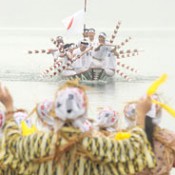
August 26, 2012 Ryukyu Shimpo
The Unjami Festival was held in Shioya Bay and other areas of Ogimi on August 25. Designated as one of Japan’s significant intangible folk cultural assets, the event features the Ugan Barley dragon boat race and Okinawan shaman or kaminchu praying for good health and a bountiful catch.
Undeterred by pouring rain, many people took part in the festival.
The Unjami Festival is held every year in the seventh month of the lunar calendar following the Bon season. The festival in Shioya dates back 400 or 500 years to the time of the Ryukyu Kingdom.
At a shrine in Tanna, the kaminchu prayed for a productive season growing grain. They then served the villagers and other participants sacred sake. At a shrine in Yafu, kaminchu holding bows in their hands moved around a pole to pray for a good harvest, chanting “Yonkoi” under “Kumu” blinds made of straw.
In the Ugan Barley dragon boat race, men rowed boats with kaminchu on board towards the coast of Shioya. On the shore women waded into the water up to their waist, cheering and beating drums as they greeted the boats.
A dance for a good harvest followed the festival the next day.
(English translation by T&CT, Mark Ealey)
Go to Japanese

Go To Video
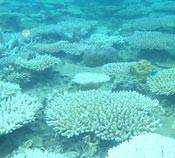
August 18, 2013 Mifuyu Hattori, correspondent of Ryukyu Shimpo
Nature guides have confirmed coral bleaching in the whole area of reefs in Kunigami. Some experts say that rising sea temperatures caused by record-breaking heat and strong sunlight have affected the condition of the coral reefs.
Large scale coral bleaching has occurred for the first time in 15 years, with the last incidence being in 1998. The bleaching that occurred in Okinawa in 2001 and 2007 did not really affect the Kunigami region, but these latest developments cause concern about the future of coral.
The bleaching has mainly occurred in the communities of stony coral such as table coral. The coral reefs in Kunigami were only slightly damaged when worldwide bleaching occurred in 1998, and it recovered over the next ten years.
On August 16, the Okinawa Meteorological Observatory announced that sea surface has reached temperatures of more than 30 C. People are concerned about large scale coral bleaching in throughout the prefecture.
(English translation by T&CT, Hitomi Shinzato and Mark Ealey)
Go to Japanese
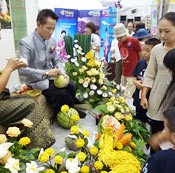
August 25, 2013 Ryukyu Shimpo
Seeking to attract tourists from Okinawa to Thailand, the Tourism Agency of the Thai Government has held the Thailand Festival at the Naha branch of Aeon, a specialist shopping mall developer, on August 24 and 25. The agency set up a space for selling miscellaneous Thai goods and introducing the country’s traditional culture.
Jumbo Tours co-hosted the festival. To commemorate launching charter flights between Okinawa and Thailand in October, the company also held a lottery for round-trip tickets.
This is the first time that the Thai government has held a large-scale event in Okinawa. The festival also introduced tours to Thailand.
There were also performances of Thai traditional arts. The exhibition included fruit and vegetable carvings, in which sculptors made flowers and birds out of watermelons and daikon radishes. It also showed off umbrella painting, traditional craft of the northern region of Thailand, in which artists draw paintings on umbrellas.
In the event, the artists painted the arms and bags of the children who took part.
Pornprapa Lawsuwan, the head of Fukuoka Office of the Tourism Agency of the Thai Government said, “There has been a long relationship between Thailand and Okinawa. Thailand sees more visitors from Okinawa than ever before. Mutual understanding leads to further increases. We held this festival to commemorate the launch of operating charter flights between Okinawa and Thailand. We hope that holding the event will contribute to the launching of regular flights.”
(English translation by T&CT, Mark Ealey)
Go to Japanese
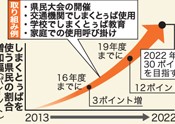
August 21, 2013 Naoki Isa of the Ryukyu Shimpo
The Culture Promotion Division of the Okinawa Prefectural Government published the Shimakutuba Promotion Plan Proposal on their website on August 20. The division aims to pass on the endangered Shimakutuba or the Okinawan language, to the next generation. They will publish the percentage of Shimakutuba users found out through the survey the government conducts for people in Okinawa.
Compared with the percentage calculated in the 2013 survey, the government aims to raise it three percent by 2016, 12 percent by 2019, and 30 percent by 2022. They will promote the language among Okinawan people and will examine the results of their projects in a survey conducted every three years.
They will gather preliminary results of the survey before the prefectural convention for the language on September 18, when they will announce an official plan that takes these figures into account.
The survey asks questions including to what extent Okinawan people understand Shimakutuba and what they should do to promote it. With the question on how much Okinawan people use the language in conversation, people who answer that they use it 1) mainly, 2) as much as standard Japanese or 3) for casual greetings, will be defined by the government as using it. If 30 percent of residents questioned in the fiscal 2013 survey answer that they use the language, the government will seek to raise that to 60 percent by 2022. The government plans to take a three-phase approach spanning ten years. During the first phase from fiscal 2013 to 2015, it will strive to make the public familiar with the language. In the second phase from 2016 to 2018, they will encourage each region to promote it and in the last phase from 2019 to 2022, Okinawan people will actively use the language.
In the plan for the first phase, the government has asked various organizations to cooperate on promotion. They will hold prefectural conventions and adopt a declaration for the language through the Promotion Movement Office. They will also encourage the use of the language on public transport and will provide opportunities for students to learn the language in national language classes and integrated studies.
The government asks for advice from researchers and encourages companies and the media to use the language. They encourage the people to take part in workshops for the language and practice it at home.
The government also seeks opinion on the projects on its website.
In 2006 the Okinawa Prefectural Assembly set up Shimakutuba Day to be held every September 18. UNESCO recognized Okinawan language, Miyako language, and Yaeyama language as endangered languages in 2009.
(English translation by T&CT, Megumi Chibana and Mark Ealey)
Go to Japanese
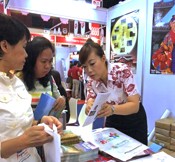
August 21, 2013 Ryukyu Shimpo
The Okinawa Convention and Visitors Bureau took part in the Thai International Travel Fair from August 15 to 18.
Four companies and one group from Okinawa including the Naha City Tourist Association, Zuisen Shuzou Distillery and Station Hotel Makishi were represented at the fair, which is the largest of its type in Thailand.
In addition to the representatives promoting tourism to the prefecture, the Okinawa traditional performing group Kaji Mai performed Okinawan martial arts and eisa dance.
Taking part in the fair for the first time, the association gave out Thai language pamphlets to visitors.
The Japanese government having exempted Thai tourists from needing tourist visas since July 1 has led to an increase in tourists visiting Japan from Thailand.
A representative of the bureau said, “We took part in the fair because we want to attract Thai customers. We intend to build recognition of Okinawa tourism in Thailand.”
(English translation by T&CT, Mark Ealey)
Go to Japanese
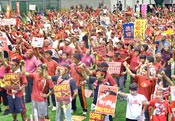
August 23, 2013 Ryukyu Shimpo
Ginoza residents held a protest rally at the Ginoza Dome in the evening of August 22 in response to the U.S. military helicopter crash earlier that month. Wearing red headbands to indicate their protest against the U.S. military, about 1,100 people from Ginoza and neighboring towns and villages took part. The participants raised their fists in anger to protest against the helicopter crash and to seek the reduction of the excessive burden that U.S. bases place on the residents. Just before the rally started, an HH-60 helicopter flew overhead. Because this is the very same model as that which crashed, many people yelled that the U.S. military was trying to make fools of the participants in the rally. This is the fifth time that Ginoza residents have held a rally to protest against the damage caused by U.S. military bases.
To great applause, the protesters adopted resolutions calling for the suspension of HH-60 helicopter flight training until the military determines the cause of the accident, takes preventive measures and offers compensation for damage. They also called for the withdrawal of all the Osprey aircraft.
In his speech, Mayor Atsushi Toma expressed a strong feeling of unrest that the U.S. military helicopter crashes have occurred three times in the area. He complained, “This is not a rally to assert political ideology. This is about protecting our lives and property.” He also appealed to the people, saying, “We must convey our ideas and feelings to Japanese and U.S. governments that reducing the burden of the bases on Okinawa must be taken seriously.”
Zenko Nakada, president of the Aged People Club Union, Takeshi Oshiro, the head of Ginoza Ward, Tetsuya Hirata, a third-grade pupil of Ginoza Junior High School and Kumiko Shimada, a member of the Matsuda District Women’s Association also gave speeches. Residents cheered, repeating Gambaro! (Let’s keep doing our best.)
On August 23, the members of the Ginoza Village Council on the U.S. Military Base Issues visited the Okinawa Defense Bureau and the Okinawa Prefectural Government to hand over the resolution statements.
The accident in question, in which one soldier died, occurred in the Central Training Area near Camp Hansen in Ginoza on August 5. An HH-60 helicopter belonging to Kadena Air Base crashed and burst into flames near the Okawa Dam during rescue and survival training. Wildfires occurred twice after the accident. When the U.S. military banned civilian aircraft from flying over the accident spot without legal basis, the Japanese Ministry of Land, Infrastructure, and Transport merely rubber stamped this action, inviting criticism of both the Japanese government and the U.S. military.
The U.S. military is regulating inspections of the crash site by the Japanese side, including Ginoza officials. The Ginoza Village Office has suspended the drawing water from the Okawa Dam reservoir until they confirm that it is safe to drink. The Okinawa Prefectural Government has taken samples of soil and water from the dam to check for the presence of radioactive materials or toxic substances.
(English translation by T&CT, Mark Ealey)
Go to Japanese
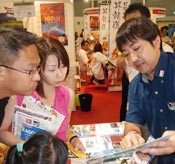
August 20, 2013 Ryukyu Shimpo
From August 16 to 18, the Okinawa Convention and Visitors Bureau, and Okinawan travel companies took part in the Natas Fair, the largest travel fair in Singapore. Seven companies and one group, including the Okinawa Tourist Service, Hotel JAL City Naha and the diving shop Shisa participated from Okinawa.
They sold Okinawa travel commodities for charter flights between Naha and Singapore and existing routes to Okinawa mainly via Taipei. More than 70 people purchased a travel package.
While the number of tourists coming to Japan has decreased after the Great East Japan Earthquake, demands for tour packages to Japan are recovering in fiscal 2013 to pre-disaster level.
The number of tourists coming to Okinawa in fiscal 2012 was 1,600, up 1.6 times on the same period the previous year.
(English translation by T&CT, Mark Ealey)
Go to Japanese
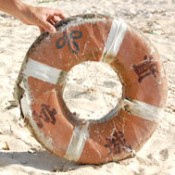
August 13, 2013 Yukito Kinjo, Correspondent of the Ryukyu Shimpo
On August 8, a lifebuoy drifted from Miyagi Prefecture was found on the sandy beach in Ara, Ie-jima Island. Forty pupils from Fukushima and Miyagi elementary and junior high schools were surprised to see it. They visited the island on the Tidakids Project, which invites children to Ie-jima from areas affected by the Great East Japan Earthquake and tsunami. They were trying drive-fishing that day. The Ie Fisheries Cooperative Association found the lifebuoy when cleaning up the beach before the drive-fishing. The letters and logo of Miyagi Prefecture were printed on the lifebuoy and its torn cover was proof that it had been drifting for a long time.
Shintaro Marukawa, a 13-year-old junior high-school student from Miyagi, said, “This reminded me of the earthquake disaster. I was impressed that the lifebuoy had come all the way to the beach where we were drive-fishing.”
(English translation by T&CT, Hitomi Shinzato and Mark Ealey)
Go to Japanese
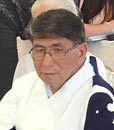
August 12, 2013 Ryukyu Shimpo
Nine Japanese people left behind in the Philippines in the chaotic times at the end of World War II are visiting Japan in order to get Japanese nationality. The father of Antonio Takara, from Baguio, who had interviews at the Tokyo Family Court on August 8 and 9, is Okinawan. The NPO Philippine Nikkei-jin Legal Support Center revealed that before Antonio’s birth, his father was held in a prison camp after the war and later returned to Okinawa. Antonio said that he wanted to set up his family register and to visit Okinawa.
The center that brought them to Japan, held a meeting at Shufukaikan in Yotsuya, Shinjuku on August 11 to talk with second-generation Japanese people left behind in the Philippines. They stated that they will strive to regain Japanese nationality for the people.
Among those Japanese left behind in the Philippines who came to Japan this time, Antonio is the only person with his background clarified. The center will continue to look into the history of the other eight people.
(English translation by T&CT, Lima Tokumori and Mark Ealey)
Go to Japanese
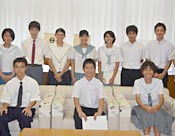
August 18, 2013 Ryukyu Shimpo
Ten students from five junior high schools in Urasoe took part in a peace education session held in Nagasaki from August 8 to 10. They met students who came from all over the country as peace delegations.
After returning to Okinawa, they visited Urasoe mayor Tetsuji Matsumoto at the city hall to report about the memorial service for the atomic bomb victims and the youth forum that they attended. One of the students who listened to atomic bomb victims speaking, said, “I learned about the horrors of the atomic bomb and that all wars only lead to tragedy.”
Before traveling to Nagasaki, the students learned about the Battle of Okinawa by visiting the sites in Urasoe, Ginowan and the southern area of Okinawa.
Takeru Kawamitsu said, “Graphic explanations of the damage done by the atomic bomb made me understand the horrors of war and the preciousness of peace. I want to let people around me know about my experience.”
Mayor Matsumoto said, “The reports from the students impressed me. Wars make no one happy. I want them to remember their experience and pass on the story to their friends, family members and the following generation.”
(English translation by T&CT, Mark Ealey)
Go to Japanese












 Webcam(Kokusai Street)
Webcam(Kokusai Street)


